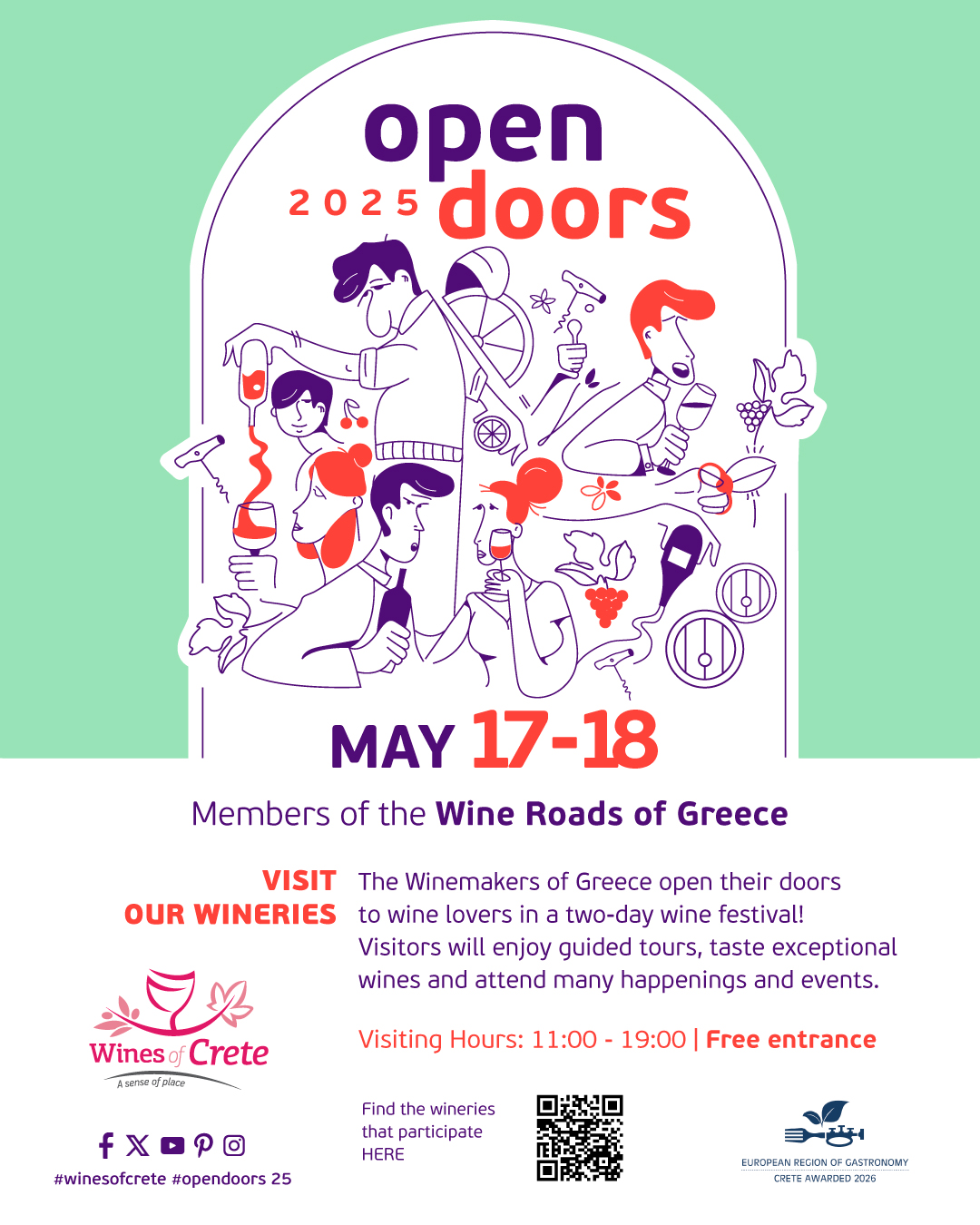Greece: Europe’s Newest Wine Country
In Greece—between the Peloponnese, Macedonia, and the shores of Crete—T+L finds welcoming people, seductively simple food, and unforgettable Greek wines.
I might have fallen as hard for Plyto in a tasting room or over dinner at home, but the setting of our first encounter made it inevitable. I was on a sloop, sailing past the stone bastions of Spinalonga, the mysterious Venetian fortress off Crete’s northern coast. Friends I’d met just that afternoon had laid out meats and cheeses beside canapés that looked like miniature sculptures. The sea was shimmering, the sky a shade of El Greco blue.
Then came wine, from a grape variety I hadn’t encountered in two decades of seeking out the stuff around the world. Not only did Plyto have historic importance—found only on Crete, it was rescued from near extinction by a determined vine grower in the 1980’s—but its thirst-quenching, green-apple bite also made it the perfect beverage for a perfect moment.
But that’s Greece. You can visit more famous wineries elsewhere, and drink bottles far more renowned (and certainly more expensive) while eating elaborate meals in your fanciest clothes, yet I’ve found few places where exploring wine regions is more fun. Almost everywhere I went during my two-week journey, I found panoramic vistas, intriguing wines, and hospitality on an Olympian scale. (Driving in Macedonia, I stopped for gas, walked inside to pay, and found a family of five eating homemade lentil soup that they insisted I sample.) It isn’t all rustic tavernas and glorified pensiones, either. That sloop belonged to Elounda’s Blue Palace, a sumptuous, 251-room hotel on a hillside overlooking Spinalonga that ranks for sheer magnificence with anyplace I’ve ever stayed.
You’ve heard that wine tastes better where it’s produced, but that truism is especially valid in Greece. Greek food is famously simple: no elaborate postmodern constructions or complex sauces here. That leaves space for the wines to show themselves. And a palate needs steady exposure to get accustomed to the singular flavors of the country’s grapes. At home, compared with Pinot Noirs and Cabernets, Greek wines can seem rustic, unsubtle, even strange. But calibrate your taste to their sturdy architecture and you’ll start daydreaming about which to have with dinner.
America’s boom in fine Greek restaurants has helped lift the profile of Greek wine. “We’ve been making it for four thousand years, but still hardly anyone knows it,” lamented Yiannis Paraskevopoulos of Gaia Wines, which has wineries in the Peloponnese and on Santorini. But nobody needs to be sold on the charms of traveling in Greece. Though the financial crisis has cast a shroud over the tourism industry—and credit card machines, which create a record of a meal or hotel stay for tax purposes, seem to be “broken” at every turn—Greeks couldn’t treat a visitor badly if they tried. Here are three regions that combine delicious food and surpassing natural beauty with memorable hotels, and wines that might even make you fall in love.
Crete
If you visit only one destination in Greece, make it Crete. Sure, the trashy beach resorts and general decrepitude in and around Iráklion, the island’s biggest city, have a decidedly Third World air. Driving is perilous, meals can be overpriced, weather frustratingly erratic. Even its barren mountains can seem inhospitable and menacing.
But persevere. Crete is a special place, where the distilled essence of Greece is augmented by African, Turkish, and other influences. For wine drinkers, the island is like Darwin’s Galápagos. The catalogue of grape varieties found mostly, or only, on Crete is more varied than that of anywhere I’ve been. If you have even a vague interest in wine, a few days on the island are sure to bring out your inner geek. If you’re into it to begin with, well, it’s like finding buried treasure.
That’s how I felt when I tracked down Lyrarakis, the producer of that marvelous Plyto. I found the winery in the rural hills south of Iráklion, after my GPS had led me through a tangle of rutted roads. The winemaker met me bearing an armful of bottles, then went back for more, for Lyrarakis produces 17 different wines, none priced above $38. Soon I was immersed in a crash course in ampelography, the study and classification of grapevines. I tasted Vilana and Dafni, Vidiano and Kotsifali, Mandilari and Thrapsathiri—not one of which, as far as I’m aware, has ever been commercially planted in the United States. Some, such as the massively structured Mandilari and the Plyto, were good enough that I schemed to ship a case home.
Nearby, past the famous Knossos ruins (which, sadly, have been “restored” to the extent that you can’t tell whether a fresco is a 3,500-year-old original or a recent fabrication), is Boutari Wineries. The company owned by Yiannis Boutaris’s family makes 2 million bottles a year of Moschofilero alone, yet its glass-walled Cretan facility (one of several in Greece) feels surprisingly intimate. The featured players on the day I visited were an evanescent white blend called Fantaxometocho, colloquially referred to as “ghost wine,” and an impish middle-aged woman, Maria Konstantaki, who arrived from the kitchen bearing warm zucchini pie, bread with tomato and feta, and yogurt with sweet grapes. “Cuisine of the grandmother,” she called it, then gave me a hug to show she meant it.
After two nights at the Blue Palace, I moved to Earino, a three-cottage hilltop inn renowned for its farm-fresh food. A chapel the size of a magazine kiosk sits on the property, and one morning of my visit coincided with the only religious service held there each year, on the anniversary of the death of the proprietor’s mother. When I heard bells, I stepped outside my room to see villagers seated in metal chairs positioned around the courtyard. They were dressed in hand-sewn clothes of bright blue and white, the same hues as the sky above and the cottages around us. It might have been a hundred years ago, or a thousand.
A day later, in Canea, or Chania—a small coastal city of warrens and passages, blind alleys, souvenir shops, and restaurants serving provocatively traditional dishes such as spiced rabbit with escargot—I walked along a seawall to a lighthouse that had been built by the Egyptians. I checked in to Casa Delfino, a 17th-century Venetian mansion with a spa, an authentic Turkish hammam, 500-year-old stones, and a roof terrace. Then I drove into the hills to see the Manousakis Winery.
The scene was almost comically rustic. Picture an unsteady table in a backyard, flies buzzing, roosters crowing, apricots and lemons swaying drowsily from trees. Except that pouring me a glass of their Nostoswine was Alexandra Manousakis, a pretty 28-year-old from Washington, D.C., whose father, Ted, owns the Bread and Chocolate chain there. Nostos, it turns out, means nostalgia, which is what Ted, who left Crete for America at 11, felt keenly whenever he returned to visit. So he started a winery, and Alex, an NYU grad who had previously worked for a New York marketing firm, agreed to tend it.
Instead of local varieties, Ted planted the grapes of the Rhône. “My father wasn’t living here, so he had no loyalties to Greek grapes,” Alex told me. Nostos’s blend of Syrah, Mourvèdre, and Grenache, typically found in Châteauneuf-du-Pape, rumbled with dark earthiness, and the varietal Syrah showed all the requisite blue and black fruit.
Each time I took a sip, a rooster crowed. A few years before, newly relocated from Manhattan, Alex might have been startled. Now she just smiled and lifted an eyebrow, as if such a thing happened all the time on this magical island. Maybe it does. I wouldn’t be surprised.


